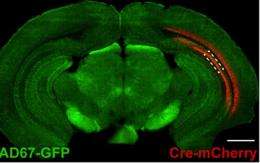Researchers have found new role for mTOR in autism-related disorders

(Medical Xpress)—Researchers have found a novel role for a protein that has been implicated in an autism-related disorder known as tuberous sclerosis complex (TSC).
The disease, which affects 1 in about 8,000 children, manifests itself in the form of mental retardation in addition to severe epileptic episodes. The disease is caused by mutations in two tumor-suppressing proteins, TSC1 and TSC2.
"Kids with this condition have benign tumors that grow all over the body," said Bernardo Sabatini, the Takeda Professor of Neurobiology at Harvard Medical School and senior author of the study, "but we wanted to know what happened in the brain."
The researchers found that when mutations in TSC1 and TSC2 adversely affected a third protein, mTOR, this mutation increased brain activity, which can result in epileptic seizures.
The findings were published in the May 8 issue of Neuron.
A protein kinase, mTOR is responsible for controlling cell growth in many parts of the body and has been widely implicated in epilepsy and autism. TSC1 and TSC2 normally repress the activity of mTOR to keep cell growth in check. In the case of TSC, there are mutations in TSC1 or TSC2, and mTOR's ability to promote cell growth goes unchecked, resulting in tumors in regularly dividing cells.
"But neurons don't divide," said Sabatini. "So it was important to note the changes in these non-dividing cells."
The researchers hypothesized that mTOR's function in the brain related to homeostasis, the brain's ability to maintain a controlled level of electrical activity. When there's a lot of electrical activity, a negative feedback system switches on to suppress activity. Conversely, when levels are too low, other positive feedback pathways are engaged that bring the activity level back up.
"We went into this study with the specific hypothesis that mTOR would be part of the homeostatic loop in the brain," explained Sabatini.
In the case of TSC patients, they thought that mTOR was incapable of maintaining homeostasis and kept adding to the level of electrical activity, leading to seizures.
"But we were wrong," he added.
"What we actually found was that mTOR is part of a positive feedback pathway," said Helen Bateup, HMS research fellow in neurobiology and first author on the study. "When a cell is active, mTOR gets turned on more frequently and makes the cell even more active by reducing the amount of inhibition that the neuron receives."
In cells where TSC proteins are mutated, this positive feedback gets out of control, and the neuronal circuit remains overactive despite all the pathways that normally shut down activity being turned on.
"It's like the circuit is trying to keep itself quiet, but it can't," said Sabatini. "The out-of-control mTOR causes some cells to loss all inhibition, something that can't be compensated for by turning down excitation."
The researchers think this key difference in how mTOR operates, in working to promote electrical activity, is important for the disease because patients end up with high levels of dysfunctional mTOR that makes for highly active circuits prone to epileptic fits. Furthermore, "we know that once a person has one seizure, they're much more likely to have more, a concept known as kindling," said Sabatini.
These findings are among the first to show that contrary to scientific consensus, mTOR does not play a part in everything.
"We have shown that one of the few things that mTOR does not seem to partake in is this negative feedback pathway," said Sabatini.
Working in both in vitro and in vivo mouse models, the researchers think the next step would be tease out the molecular pathway of mTOR's involvement in this positive feedback loop. "It's also important to compare how this pathway works in normal brains versus a diseased model," added Bateup.
"A huge challenge when studying the brain is that there are so many feedback pathways that a mutation in one gene can result in a hundred other secondary changes," said Sabatini.
Rapamycin, a drug currently used to prevent organ rejection following transplants, targets mTOR and brings activity levels back to normal.
"We could use the drug to restore this excitatory-inhibitory balance in the brain," said Bateup. "A lot of drugs that treat epilepsy try to make inhibition more powerful but given that the primary problem here is that a group of cells has lost inhibition, that approach won't work," she added. "What we might need is to target the excitation side. Or find ways of changing the biochemistry of the cells to make inhibitory synapses again."
"For this disease, this is the right time to start looking at human cells," said Sabatini. "We have really good data from the mouse model and it would be a really nice test to see if the mouse model is really predictive of human disorder and if it's worth being continued."
More information: www.sciencedirect.com/science/ … ii/S089662731300264X

















